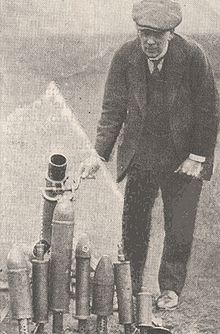Stokes mortar
The Stokes mortar (English Stokes Mortar ) was a British mortar developed in 1915 .
history
The Stokes mortar was developed by Sir Wilfred Stokes KBE in 1915; it was named after him. The mortar was indeed no really new weapon in the British Army, but tried this one the German mortars to develop equivalent mortar. In addition, the mortar should be lighter than its German counterpart. Originally only the German mine thrower was intended to be copied, but the redesign resulted in a completely new way for more modern infantry support weapons. The basic concept of the Stoke mortar can still be found today in modern grenade launchers .
commitment
The weapon was used by the British Army, the British Commonwealth of Nations, and the United States during the second half of World War I. It was operated by two soldiers and had a range of 700 to 800 meters. Up to 25 rounds could be fired within a minute. At the time of the armistice, the British Army was using 1636 Stokes mortars. During the fighting in 1918, the mortar stood out in particular. While the German troops had to partially leave their heavy equipment behind, the British were able to carry the light mortar and thus always had artillery support.
technology
The weapon consisted of a barrel placed on a bipod; a base plate gave the weapon stability when firing and absorbed the recoil. The entire mortar was moved to straighten the sides. A thread was attached to the bipod to adjust the height. The weapon was aimed accordingly by simply turning the crank. The size of the gun allowed it to be fired even from narrow trenches. A grenade with an impact fuse was used, while other artillery shells still had setting fuses. This had the advantage that the detonator of the grenade was easier to manufacture. In addition, the ammunition was in one piece. This in turn meant that far fewer or smaller means of transport could be used to transport ammunition than with conventional artillery.
Technical specifications
- Caliber: 81 mm (3.2 inches )
- Core length of the tube: 1150 mm
- Elevation range: 45–75 °
- Shot rate : maximum 25 rounds / minute (as a rule 6–8 rounds / minute were fired)
- Bullet: high explosive / 4.54-5 kg (10-11 pounds ) weight
- Range: maximum 720 m
Web links
- Description of the Stokes mortar by the OHL intelligence officer at Army High Command 7 on November 2, 1917. Central Archives of the Ministry of Defense of the Russian Federation. German booty files from the First World War. File 85, B. 11ff. Digitized
literature
- Ian Hogg : 20th Century Artillery. Gondromverlag, Bindlach 2001, ISBN 3-8112-1878-6 .
- Tillmann Reibert: The development of the grenade launcher in World War I: the emergence of a new type of weapon as a reaction to the conditions of trench warfare. State and University Library, Hamburg 2013, DNB 1033403466 (Dissertation Universität Hamburg 2013 Supervisor: Gudrun Wolfschmidt , 509 pages full text online PDF, free of charge, 509 pages, 19.797 MB).
- Pages 187 to 197 (illustration)
- Pages 216 to 223 (evaluation / comparison)
